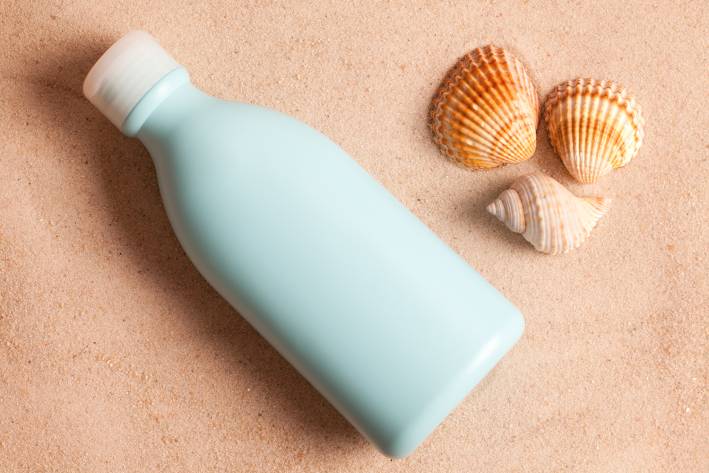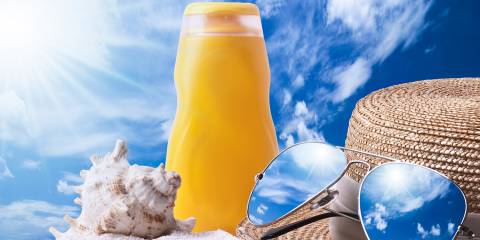Tis the season to celebrate all things light, from reading to clothing to the rays pouring down from the sky.
Yet it pays to be cautious about sun exposure. By age 70, one in five Americans will contract melanoma, the deadly skin cancer, according to the Melanoma Research Foundation. For that reason, it's best to seek shade from 10 am to 4 pm, when the sun's rays are strongest.
Is there such a thing as a healthy tan? “Most consider it an oxymoron,” says David E. Fisher, MD, chief of the Department of Dermatology at Boston’s Massachusetts General Hospital.
Products to Protect Your Skin
Sun-safe options run the gamut from sunscreen and lip balm to self-tanning products, clothing, and even supplements. With these kinds of choices, you can get the most out of your lazy days without breaking a sweat.
Sunscreen Tips
Proper Sunscreen Usage
“Put on often; slather on thick,” says Dr. Fisher. He recommends a broad-spectrum sunblock that protects against UVA and UVB rays. UVB is the culprit when it comes to most cancers, but UVA, responsible for premature wrinkling and aging, can also damage DNA.
Use sunscreen daily if outside for more than 20 minutes. Apply 30 minutes before sun exposure. Reapply often, every two hours, if it’s humid or you’re swimming or perspiring heavily. Choose a sun protection factor (SPF) of 30 year-round.
Safe Sunscreen Ingredients
Most oil-based sunscreens don’t contain enough SPF, so opt for cream or lotion. Many natural products contain additional healthful ingredients such as vitamins E and C or green tea.
Kat James, author of The Truth About Beauty, recommends choosing a mineral-based sunscreen (zinc oxide or titanium dioxide) for optimum safety. Mineral sunscreens are called physical sunscreens because they block the sun's harmful rays from penetrating skin.
Chemical sunscreens contain UV filters like oxybenzone, avobenzone, octisalate, octocrylene, homosalate, and octinoxate. Unfortunately, many of these active ingredients were grandfathered and approved by the FDA without evaluating their safety. In 2019, the FDA determined that out of the 16 commonly used sunscreen filters, 12 lacked sufficient health and safety data.
Oxybenzone, found in 40 percent of the products evaluated in 2020 by the Environmental Working Group (EWG), has fewer data gaps than other chemical filters, but some evidence suggests it is more easily absorbed into the skin and could be a potential endocrine disruptor. Endocrine disruptors are chemicals linked to problems with growth and development, reproduction, immune and nervous system function, and may even pose an increased cancer risk.
Children appear to be more likely to suffer harm from oxybenzone due to the "potential for higher absorption and bioaccumulation," EWG reports.
In 2021, the state of Hawaii banned the sale of products containing octinoxate and oxybenzone. Both, even in small amounts, are toxic to coral reefs.
What to Look for in Lip Balm
Lips get sunburned, too, so apply protection that’s SPF 15 or higher; many lip balms come in pretty summer tints.
Self-Tanners
“If a tan is induced by UV radiation, there’s no evidence that it’s a safe tan,” says Dr. Fisher. He adds, “A sunless tan is a safe tan.”
Kat James recommends a bronzer with mineral pigments (iron oxides), which allows for even application.
Supplements that Protect Skin
For protection from the inside out, some studies support the use of vitamins B3, C, and E and beta carotene to counteract the damaging effects of UV radiation. Other potentially protective phytochemicals include astaxanthin, lycopene, pine bark extract, and caffeine.
Certain herbs such as St. John's wort and dong quai can increase your chance of sunburn, so use caution in the sun if you take these supplements.
As for that much-needed by-product of the sun, vitamin D, Dr. Fisher feels that sun exposure is “a carcinogenic way to get vitamin D. It comes at a price—skin cancer.” He notes, “Vitamin D supplements are chemically identical, functional, and will fully replace the vitamin D we would receive from the sun.”





